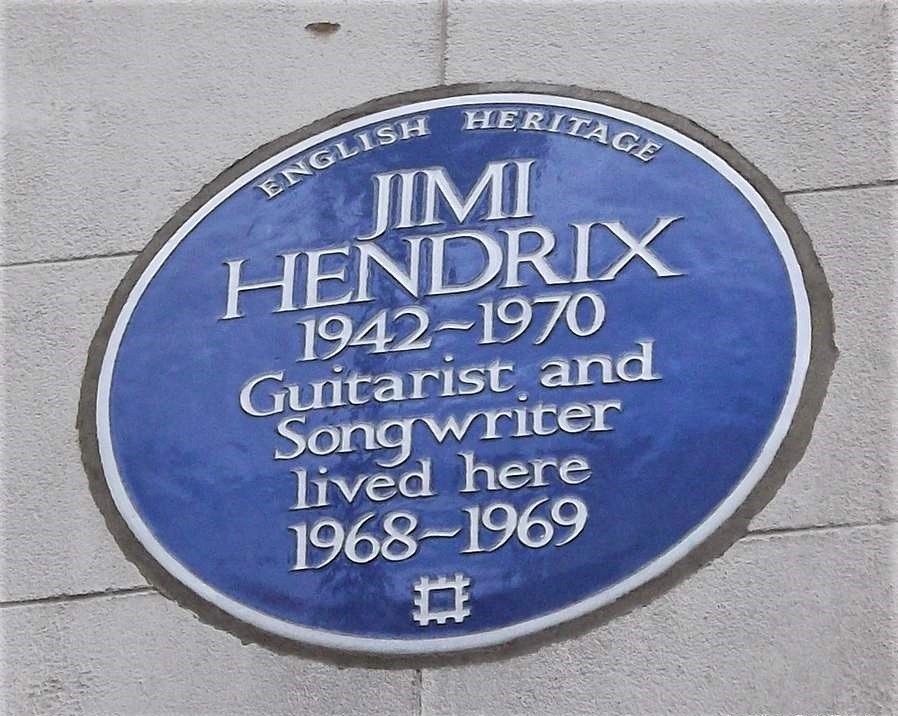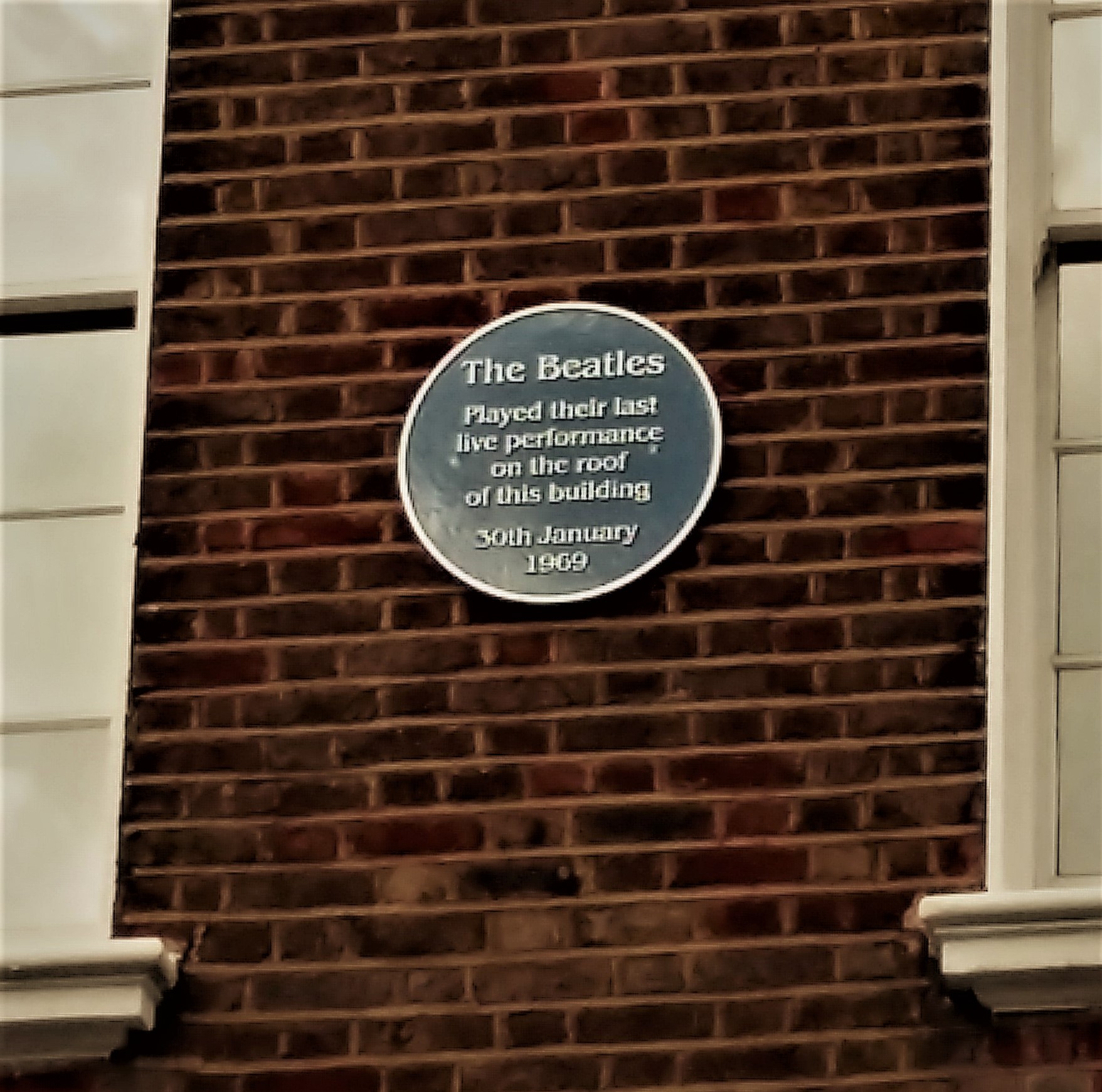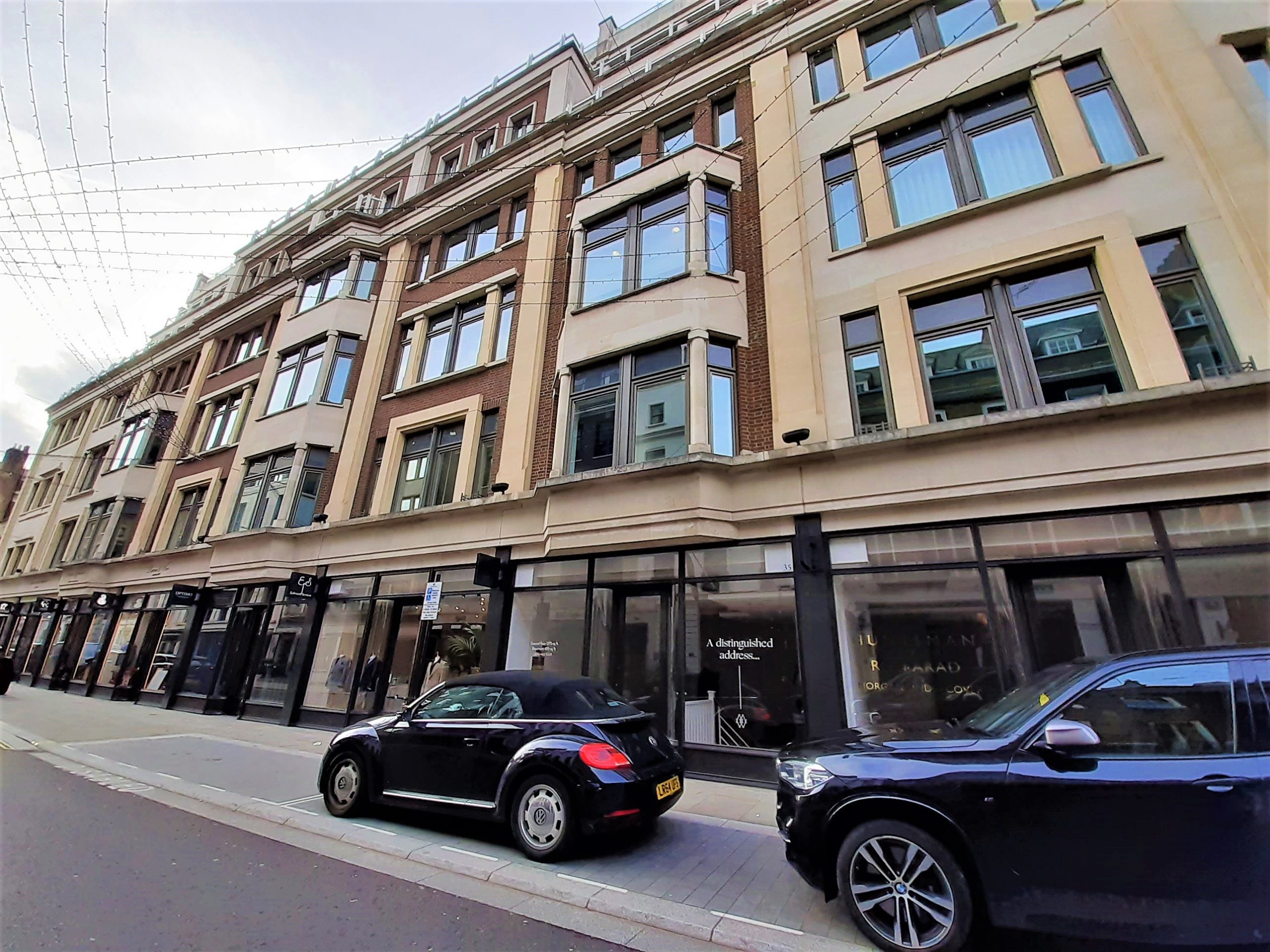The Beatles (and Hendrix and Bowie) in London: Part 2 – Mayfair (including Ziggy Stardust record cover key facts).
Posh Mayfair, upmarket Mayfair, moneyed Mayfair, you get the picture; it’s nice in Mayfair. Mayfair is in the West End of central London, which is not one district but a patchwork of neighbouring areas that developed through the 17th and 18th centuries (St James’s, Covent Garden and Soho were others). The West End formed the mainly well-to-do areas developing west of the ancient City of London and, you could say, was the launch pad for the suburbanisation of London becoming the 607 square mile sprawl it is today.
Mayfair gets its name from the fair which took place there every May from the 1680s until the 1730s. This had previously been an undeveloped, mainly rural landscape but the Great Fire of London in 1666 changed all that and soon these new westerly districts for the wealthy began to develop. Who amongst the recently ensconced rich would want a raucous, libidinous jamboree on their doorstep for the first two weeks of every May? None, is the answer; so the May fair ended but they liked the pretty name, so that stayed.
Mayfair today is a mix of very expensive residential addresses, a few embassies, high end shops and restaurants and a significant commercial presence. The area has maintained its fine architectural heritage and charm and has always attracted the famous, fashionable and what are nowadays called HNWIs*. From its beginnings Mayfair has always had musical connections. Let’s explore how three giants of UK and US rock’n roll got themselves connected (also see: The Beatles in London: Part 1 – St John’s Wood).
| If you would like to experience my Beatles + More Rock’n Roll Tour that’s easy. Choose my private London tour:
Private tours, door-2-door service, pickup and drop-off, 6 people maximum, I explain as we explore. |
Jimi Hendrix Blue Plaque – 23 Brook Street, London W1.
James Marshall ‘Jimi’ Hendrix (born Johnny Allen Hendrix, 27 November 1942 – 18 September 1970) was born in Seattle and began playing guitar aged fifteen. In 1961 he enlisted in the US Army and trained as a paratrooper in the 101st Airborne Division, but was discharged the following year. He moved to Clarksville, Tennessee soon after and began playing with a succession of well known artists and bands including Wilson Pickett, Slim Harpo, Sam Cooke, Ike & Tina Turner, Jackie Wilson, the Isley Brothers and Little Richard.
Jimi Hendrix in London.
By May 1966 Hendrix was struggling to earn a living on the R&B circuit, so he briefly rejoined Curtis Knight and the Squires for an engagement at the Cheetah Club in New York. During one performance Linda Keith, the girlfriend of Rolling Stones guitarist Keith Richards, noticed Hendrix and was mesmerised by his playing. She asked him over for a drink and the two became friends.
Keith recommended Hendrix to Rolling Stones manager Andrew Loog Oldham, who failed to see his potential. She then referred him to the Animals bassist Chas Chandler, who was on the verge of leaving the group and getting involved in managing artists. Chandler saw Hendrix play at Cafe Wha? in Greenwich Village, liked what he saw and was especially impressed with Hendrix’s version of the the Billy Roberts song ‘Hey Joe’. He signed him and brought him over to London on 24th September 1966. It’s said Hendrix changed his name to Jimi on the flight over.
During his first night in London Hendrix gave a spontaneous solo performance at The Scotch of St James, which was a drinking club frequented by every British rock’n roller listed in the British rock’n roll compendium of British rock’n rollers, including Chas Chandler. Paul McCartney also happened to be there that night, nursing a quiet pint.
On the 1st October Chandler took Hendrix to the Central London Polytechnic in Regent Street, where Cream were about to do a student gig. Hendrix and guitarist Eric Clapton got chatting and later on, halfway through Cream’s set, Hendrix took to the stage and performed the Howlin’ Wolf song ‘Killing Floor’.
Jimi Hendrix in Brook Street.
In 1723 George Frederick Handel (1685-1759), the German born court composer to King George I and his son King George II moved into 25 Brook Street, a fine terraced house in the fashionable new London suburb of Mayfair. In July 1968 Jimi Hendrix moved into 23 Brook Street.
The Handel House Museum opened in 2001. It comprises of carefully restored period rooms in 25 Brook Street with exhibition rooms in the now conjoined 23 Brook Street. In 2016 the museum expanded to become the ‘Handel and Hendrix in London’ museum, incorporating rooms designed as Hendrix had furnished them.
There are two blue plaques* on this building. The first is dedicated to Handel and the second to Hendrix. 
It was Hendrix’s girlfriend Kathy Etchingham who found a newspaper advert for the £30 a week flat, which came with a fully fitted kitchen and a modern pink bathroom suite. Hendrix also gave Etchingham £1,000 in cash, a lot of money in 1968, to fill it with soft furnishings from the John Lewis and Liberty department stores, both a short walk away. They moved in in July 1968. Hendrix then toured the US for a few months and moved back in January 1969. He and Etchingham split up in April 1969 and Hendrix never returned.
After his years in the army Hendrix was obsessively neat. The bed may have been draped in hippyish fabrics beneath a canopy made from an embroidered silk shawl, but it was meticulously made with hospital corners and the pillows and cushions squared up.
The kitchen didn’t get much use. Room service was supplied by Mr Love’s, the restaurant downstairs, whose waiters regularly carried up orders of steak and chips, bottles of Mateus rosé and packets of cigarettes.
Hendrix was delighted to find out that Handel had lived next door, apparently rushing out to buy some Handel records, and later insisted he had once seen the composer’s ghost step through the wall, “an old guy in a night shirt and grey pigtail”.
Hendrix died in London from barbiturate related asphyxia on the 18th September 1970 aged 27. Although staying at the Cumberland Hotel (now the Hard Rock Hotel) he died in the flat of Monika Dannemann in the Samarkand Hotel, Lansdowne Crescent in Notting Hill.
Apple Corps – 3 Savile Row, London W1.
Savile Row, long known as the street of English tailoring, was built in the early 1730s on land originally called Ten Acres belonging to a merchant tailor, William Maddox. The land had been part of the Burlington Estate and is named after Lady Dorothy Savile, wife of the 3rd Earl of Burlington. It developed into a smart residential Mayfair street.
Maddox’s land, having consisted mainly of fruit and other trees covering what would become Savile Row and the streets around, is still owned by his descendants as part of the Pollen Estate. Just north of Savile Row you’ll also find Maddox Street. Tailors started doing business in the area during the late 18th century; first in Cork Street around 1790 and by 1803 in Savile Row itself. 
When Brian Epstein died in August 1967 (see ‘The Beatles in London: Part 1’) the Beatles had no office space of their own. Apple Corps was officially created in January 1968, by which time they had already opened the Apple Boutique in December 1967. The shop premises were at 94 Baker Street and the Beatles simply used the cramped upper story’s as an office.
When this classy Mayfair building became available in June 1968 the Beatles moved in. So did the ‘Apple Scruffs’, the Beatles most dedicated fans who used to hang around on the street outside and so, for a while, did a group of American Hell’s Angels.
 The basement of the Apple Building would be the home of their recording studio aka Apple Studios. Much of ‘Let It Be’ was recorded here under the production of Phil Spector. All the Beatles subsequently made solo recordings here until 1975 when Apple Corps left the building entirely.
The basement of the Apple Building would be the home of their recording studio aka Apple Studios. Much of ‘Let It Be’ was recorded here under the production of Phil Spector. All the Beatles subsequently made solo recordings here until 1975 when Apple Corps left the building entirely.
The roof of 3 Savile Row would most famously become the scene of the celebrated ‘roof gig’ on the 30th January 1969. The gig was an unannounced happening and would be the Beatles last public performance, even though most observers couldn’t actually see them.
Most of the songs played were from ‘Let It Be’ and as the gig progressed people began to gather on the pavement outside and across the adjoining rooftops. It was all captured on film for the documentary ‘Let It Be’. After forty two minutes the police knocked on the chic white Apple Corps door and told them to stop playing – it seems a law firm around the corner had complained about the noise.
Each Beatle had an office here. John and Yoko’s was on the ground floor, first room on the right. They actually started to vacate the building in 1972 and took other office space nearby at 54 St James’s Street. It’s worth noting that the first time the general public could enter the building was after the Abercrombie & Fitch kids store opened here. They very thoughtfully designed some Beatles display cabinets and let anyone go in and take photos. Unfortunately the store has closed down and the building awaits new tenants. Will the mini exhibition ever return?
The unofficial plaque at 3 Savile Row (above) and one of the, now unseen, Beatles displays (left).
The House of Nutter – 35a Savile Row, London W1.
Tommy Nutter (1943-1992) was a British tailor, famous for reinventing and modernising the Savile Row suit in the 1960s.

35 Savile Row today. The House of Nutter building has gone and been redeveloped.
Tommy was born in Wales but raised in Edgware, where his father owned a local high street cafe. After the family moved to Kilburn Nutter attended Willesden Technical College, initially to study plumbing and then architecture. But he abandoned both aged 19 to study tailoring at the Tailor and Cutter Academy and began working in traditional Savile Row tailoring.
Nutters of Savile Row (aka The House of Nutter) was opened on Valentine’s Day 1969 by Tommy Nutter and fellow tailor Edward Sexton. They were backed financially by British singer Cilla Black (managed by Brian Epstein) and the Apple Corps MD Peter Brown. Nutters was the first shop on Savile Row to pioneer ‘open windows’ and had bold displays resulting in the shop helping modernise the perception of Savile Row.
Nutters of Savile Row dressed the entire social spectrum from the Duke of Bedford and Lord Montagu to Mayor of San Francisco Willie Brown, Mick and Bianca Jagger, Elton John and the Beatles – Paul wore a Nutter suit at his wedding to Linda. Nutters designs later included the costumes for the 1989 Batman film including those worn by Jack Nicholson.
Tommy Nutter was proudest of the fact that the suits worn by three of the Beatles on the front cover of ‘Abbey Road’ were made by Nutters (see ‘The Beatles in London: Part 1’). Nutter left the business in 1976 and went to work at Kilgour (5 Savile Row). He died on the 17th August 1992 at the Cromwell Hospital.
David Bowie Black Plaque – Heddon Street, London W1.
Heddon Street is a narrow dog-legged back street off Regent Street, backing onto Savile Row. Until the Reformation the land had been owned by the Convent of Abingdon. The Pulteney family had subsequently held the land post-Reformation since 1590 when it was known as Mulguly Close or Dog Field.
It was partially developed from the 1660s by leaseholder William Pulteney and further by his grandson in the 1720s for housing. Also called William Pulteney, and also 1st Earl of Bath, he was Member of Parliament at the time for Hedon (one ‘d’) in East Yorkshire. The street was completely redeveloped during the construction of Regent Street from the 1820s and most buildings are of 19th or 20th century origin. Heddon Street today is full of some pretty smart restaurants but it’s worth noting that until quite recently it was a rather shabby narrow lane full of workshops, warehousing and offices. It is in this Mayfair back street that we have London’s first rock’n roll black plaque.
David Robert Jones aka David Bowie (8 January 1947 – 10 January 2016) was born in Brixton. In 1953 Bowie moved with his family to more suburban Bromley.
Davy Jones’s musical journey: The Konrads (1962); The King Bees; The Manish Boys; The Lower Third; The Buzz; The Riot Squad; David Bowie (1967).
‘The Rise and Fall of Ziggy Startdust and the Spiders From Mars’: Album cover shot
It’s January 1972 and Bowie is feeling a bit fluey on this particular cold and rainy evening. But there’s a new album just recorded, the record cover needs shooting and photographer Brian Ward has been booked (he had also done the cover photography for Hunky Dory).
Ward took seventeen shots for the front and back covers (including the telephone box). All were in black and white and the final selections were tinted by artist Terry Pastor (who had also tinted the photo for the cover of Hunky Dory, released in December 1971).
The colour tints were done by hand, and applied using photo-dyes with an airbrush – a DeVilbiss Super 93. In reality the jumpsuit wasn’t turquoise and Bowie’s recently cut hair was light brown, not yellow. Pastor added the lettering using letraset and then hand colouring the letters.
The cover art concept was influenced by the recent release of Stanley Kubrick’s film version of ‘A Clockwork Orange’ and the book ‘The Wild Boys’ by William S Burroughs: urban decay and the downfall of western civilisation, but with a Brit glam-rock, music hall meets Armageddon twist.
Ziggy Stardust album cover: Key facts
- The photos were probably taken on the 13th January 1972 and the album was released on the 16th June 1972.
- Seven shots were taken outside 21 Heddon Street for the front cover (some say it was outside No 23).
- Bowie is wearing a jumpsuit designed by Freddie Burretti with fake diamond beads sewn into the crotch and Kansai Yamamoto platform boots.
- The Gibson Les Paul guitar over Bowie’s shoulder belonged to Mark Carr Pritchett of the Arnold Corns, which was a Bowie side project (Burretti was also a member).
- K. West was a furrier. The founder was Henry Konn and as the workshop was in the West End we get the name K. West. When the record was released they didn’t originally approve. Their lawyers letter spelled it out, “Our clients certainly have no wish to be associated with Mr Bowie or this record…”etc. The sign survived until the early 1980s, when it was allegedly stolen by a Bowie fan. In 1991 K. West relocated. The sign was lent to a Bowie exhibition anonymously in 2012.
- The original lamp casing is still in place and a replacement red telephone box can be found tucked into the north western corner of Heddon Street (the narrower pedestrianised part). The entire building and doors have been repainted.
- Bowie’s manager Tony Defries had his office for GEM Management nearby at 252 Regent Street.
- Ward’s studio was at 29 Heddon Street. He’d taken a few studio shots with all the band members and now wanted some outdoor photos. Bowie is by himself because the other band members didn’t want to go out into the rain.

The Rise and Fall of Ziggy Stardust and the Spiders from Mars – front cover and back cover.

Ziggy Stardust Black Plaque

David Bowie’s Ziggy Stardust black plaque in Heddon Street, London W1.
This plaque was paid for by the Crown Estate (in which Heddon Street now sits) to mark 40 years since the release of ‘The Rise and Fall of Ziggy Stardust and the Spiders from Mars’. It really commemorates the fictional character of Ziggy rather than Bowie himself.
It was unveiled on the 27th March 2012 by Gary Kemp of Spandau Ballet, in the presence of the Spiders from Mars drummer Mick “Woody” Woodmansey and bassist Trevor Bolder.
This is a black plaque rather than the more usual English Heritage blue plaque. One other rock’n roll black plaque has since been unveiled, to Pink Floyd, outside the University of Westminster further up Regent Street (formerly known as Central London Polytechnic, also see Hendrix and Cream above).
*HNWI – High Net Worth Individual.
*London Blue Plaques – since 1867 the great and the good, famous and infamous have been memorialised with a blue plaque on a building with which they are connected. A person must be dead for twenty years before a blue plaque will be considered. Since its foundation the Royal Society of Arts, London County Council, Greater London Council and now English Heritage have managed the scheme. Other bodies and societies manage other style memorial plaques.
| If you would like to experience my Beatles + More Rock’n Roll Tour that’s easy. Choose my private London tour:
Private tours, door-2-door service, pickup and drop-off, 6 people maximum, I explain as we explore. |
